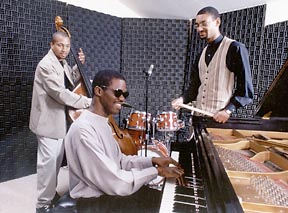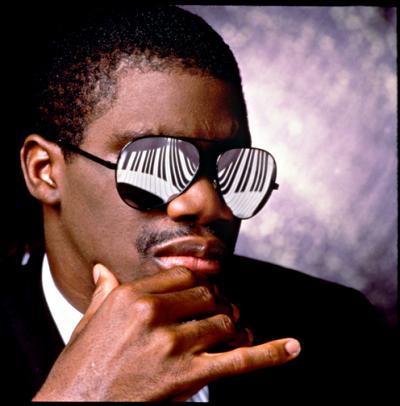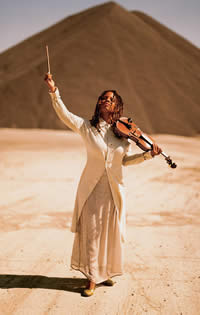
 Marcus Roberts Trio |
 Regina Carter |
|
Story by Jean Timmons In 1985, at twenty-one, pianist Marcus Roberts was playing and recording with Wynton Marsalis’ band. After his six-year stint with Wynton (his time in the shed, as it were), he became a very versatile musician, composing and recording extensively. For the Center performance, he brought his trio: Roland Guerin on bass and Jason Marsalis on drums.  This trio had the majority of the audience in its hands from the opening number, a Jelly Roll Morton blues, something with the words “New Orleans” in the title. It was interesting—a little ragtime, a little March-like beat, and lots of Jelly licks. Then the set really got interesting with the trio taking on Charles Mingus’ “Haitian Fight Song.” From that point, the trio performed one provocative improvisations after another: “The Entertainer” featured intricate solo drum work; “Mona Lisa,” a track on their Cole after Midnight CD, opened dramatically with brush strokes that blended into Roberts who enunciated the title as well as any jazz vocalists while Guerin treated the bass to a bow; Coltrane’s “Giant Steps” was just too marvelous; and “Sweet as Can Be,” presumably a Roberts composition, displayed his gospel roots that branched off into some very nice bass playing.
This trio had the majority of the audience in its hands from the opening number, a Jelly Roll Morton blues, something with the words “New Orleans” in the title. It was interesting—a little ragtime, a little March-like beat, and lots of Jelly licks. Then the set really got interesting with the trio taking on Charles Mingus’ “Haitian Fight Song.” From that point, the trio performed one provocative improvisations after another: “The Entertainer” featured intricate solo drum work; “Mona Lisa,” a track on their Cole after Midnight CD, opened dramatically with brush strokes that blended into Roberts who enunciated the title as well as any jazz vocalists while Guerin treated the bass to a bow; Coltrane’s “Giant Steps” was just too marvelous; and “Sweet as Can Be,” presumably a Roberts composition, displayed his gospel roots that branched off into some very nice bass playing.The trio was so grand that the audience cheered mightily, compelling the musicians to perform an encore. The encore was a short rendition of “Cherokee” in which Roberts dazzled us with a wizardry that conjured up Art Tatum. Part of the pure joy or entertainment of both sets was the creative use of allusions to other jazz musicians or jazz music. Of course, alluding to songs that other musicians made known is a tool of the jazz improviser. Yet Roberts and Carter were so good at it that it raised the level of audience participation. And Carter needed to involve the audience for sure following the musicianship of the Roberts trio. Regina Carter is a classically trained violinist who plays jazz. Carter’s group was billed as a sextet, but all the members weren’t able to make the concert. The bassist couldn’t make it, thence a local musician took over for him; and the accordion player listed in the program didn’t make it to the stage and was not replaced. So my curiosity about the presence of an accordion in a jazz group lingers. It was an odd collection of musicians, in a sense: Darryl Harper, clarinet; Xavier Davis, piano; Alvester Garnett, drums; and local musician, bass. This group was certainly different from the group that accompanied Carter on the magnificent Paganini: After a Dream. But then, she was playing Paganini’s violin and mainly classical music with a jazz musician’s sensibility. At Symphony Center, the compositions were eclectic. It was wise to begin the evening with “Black Orpheus,” a number she played on the Paganini. But for this concert, she laid back, way back, standing off from the group, as its members imparted a jazz interpretation to the introduction of this classic piece.  There was a very romantic edge to the piano, a Spanish (think “Bossa Nova”) rhythm. Only after a long explication of the work does Carter take over; and she was masterful. It may not have had the sustained impact of the earlier recording, but it exemplified that passion and ability to stir one’s very soul, which few musicians truly possess though many try to imitate through sheer physical exertion. For all the expectation the opening engendered, her set was not long enough for this reviewer.
There was a very romantic edge to the piano, a Spanish (think “Bossa Nova”) rhythm. Only after a long explication of the work does Carter take over; and she was masterful. It may not have had the sustained impact of the earlier recording, but it exemplified that passion and ability to stir one’s very soul, which few musicians truly possess though many try to imitate through sheer physical exertion. For all the expectation the opening engendered, her set was not long enough for this reviewer. After “Black Orpheus,” Carter announced that the next work would be a homage to her recently deceased mother, credited with making her practice long and hard on the violin, as is her recent CD titled I’ll Be Seeing You: A Sentimental Journey. With that announcement, the crowd grew respectfully quiet, but then she played an awkward series of notes that translated to “Jimmy Crack Corn.” Well, that broke up the audience and off the musicians went with a little jazzed-up country music, which included a piercing clarinet allusion to “Go Tell It on the Mountain.” The rousing “Jimmy” was followed by three other numbers. “You Took Advantage of Me,” an old chestnut show tune, swung in the typical way that a jazz violin swings and included an allusion to Parker’s “Now’s the Time” or the rhythm and blues song, “The Hucklebuck.” On “Advantage,” the group established the clarinet-violin duets that marked the subsequent pieces. “A Tisket-a-Tasket” was a swinging number, too, with a lot of work from the clarinetist, and Carter found a way to bring in a “Jimmy Crack Corn” refrain that reminded me of Stuff Smith (as seen in the fine Jean Bach film A Great Day in Harlem). The witty and ironic references sprinkled throughout the music of both sets never became strained or disruptive. And then there was the last number—“Georgia.” Carter’s opening two notes brought murmurs through the audience in anticipation of what she might do with the song. Everyone listened intently. Her blend of jazz and classical music is so exquisite it becomes indescribable. It creates a yearning for the beautiful—sunset, faraway place, love affair. Then it was over.
Check out Regina's Homepage
Check out Marcus' Homepage |